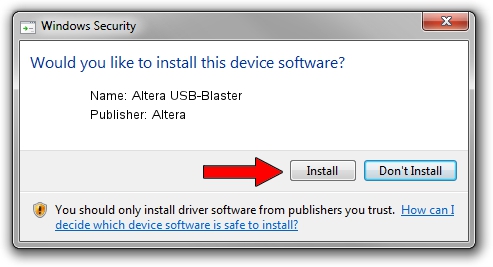
Now, the Programmer, JTAG Chain Debugger and System console should all recognize and use the USB-Blaster device. and then select the board from the drop-down list. From Quartus, select Tools, Programmer, Hardware Setup. The cable should now be recognized as a valid hardware by the Quartus tools. To test that the connection works, execute jtagconfig and hope for an output giving the board and the devices: $ jtagconfig This file allows Altera tools to translate Device IDs (left column of terminal listing below) to device names (right column) for found devices. Make sure jtagd has access to the list of devices: $ sudo cp /opt/altera/13.1/quartus/linu圆4/pgm_parts.txt /etc/jtagd/jtagd.pgm_partsĪlso make sure this file has read access for the user. NAME="bus/usb/$env.įor the changes to take effect, reboot the machine or run: $ sudo udevadm control -reload That is why edited permission for the usb_device is necessary.Ĭreate a file /etc/udev/rules.d/les, make sure it has read permissions for root, and fill it with this content: # For Altera USB-Blaster permissions. You'll usually run these as a user, which means jtagd will also run as a user.

ALTRA USB BLASTER DRIVERS SOFTWARE
If not already running, jtagd will be startetd automatically when the Quartus software or jtagconfig is run. Jtagd, part of the Quartus tools, is a deamon that provides the interface between the Altera tool accessing the JTAG chain and the USB driver. By default, only root has access to these so we must make sure the user is allowed to access them as well. The Quartus software will use the Linux built-in usb_device drivers. Take note of the Product ID listed - 6010 in the above example. usb 2-2: New USB device strings: Mfr=1, Product=2, SerialNumber=3 usb 2-2: New USB device found, idVendor=09fb, idProduct=6010 These are the commands I used and the output I got: $ dmesg|tail Verify USB connection and check Product IDĪt first, connect the cable and make sure the USB device is recognized.

This gives command-line access to the commands jtagd and jtagconfig which I use in this post. To facilitate working with the Altera software, I suggest adding the bin/ folder of the Quartus installation ( /opt/altera/13.1/quartus/bin on my system) to $PATH. In this article, I'll describe how I got it working. I was connecting to a Terasic SocKit board. With some work, I got Alteras on-board USB-Blaster working on my Ubuntu 14.04-64 installation with Quartus II 13.1.0 64-bit. Thanks to the blogger so I got it solved, and here is the article.
ALTRA USB BLASTER DRIVERS INSTALL
This is the sequence:ġ - Go to windows 10 settings and search for "advanced startup options"Ģ - Under Advanced startup, hit "Restart now"ģ - After a moment, you'll get a "choose an option" screen - choose "Troubleshoot", then "Advanced options", then "Startup Settings"Ĥ - You'll get a screen telling you what you will be able to change and a single "Restart" button - press it.ĥ - If your boot drive is BitLocker encrypted, you'll need to enter the recovery key (press return, enter the key in the text box then hit return again - it took me three goes to realize I had to hit return before I could enter they key !)Ħ - You'll be given a menu of options, number 7 disables driver signature enforcementħ - When the PC restarts, use Device manager to update the drivers - this time you'll get a warning about the signature, but they install fine.I was having the problem: unable to program the Altera FPGA board with USB-Blaster, and even failed to auto-detect.Īuto-detect gave me a message: "Unable to scan device chain.

You first have to disable driver signature enforcement.


 0 kommentar(er)
0 kommentar(er)
